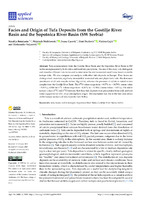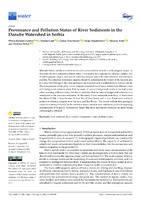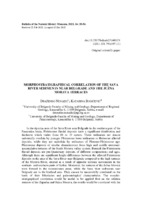Претрага
114 items
-
Hydrographic and hydrological characterization of the Vodenička and Rosomačka rivers
Vesna Ristić Vakanjac, Marina Čokorilo Ilić, Dušan Polomčić, Dragoljub Bajić, Jelena Ratković (2017)The Visočica River rises in Bulgaria, on the Berovo Mountain. Its course in Bulgaria is 16.7 km long. It enters Serbia near the village of Donji Krivodol. Up to the village of Pakleštica, or the beginning of Lake Zavoj, its right-bank tributaries are the Krivodolštica, the Vodenička, the Rosomačka and the Dojkinačka. There are no left-bank tributaries. Among the tributaries, water levels and discharges are gauged only on the Dojkinačka River. The Vodenička had also been gauged but only ...Vesna Ristić Vakanjac, Marina Čokorilo Ilić, Dušan Polomčić, Dragoljub Bajić, Jelena Ratković. "Hydrographic and hydrological characterization of the Vodenička and Rosomačka rivers" in Pirotski zbornik, Pirot : Narodna biblioteka Pirot (2017). https://doi.org/10.5937/pirotzbor1742001R M53
-
Anthropogenic impact on the groundwater regime: Case study of the Velika Morava alluvium
Jovana Mladenović, Vesna Ristić Vakanjac, Milan Kresojević, Boris Vakanjac, Jugoslav Nikolić, Dušan Polomčić, Dragoljub Bajić (2023)The Velika Morava River originates at the junction of the Južna Morava and Zapadna Morava at the town of Stalać in Serbia. It is 185 km long and empties into the Danube. The Velika Morava River Basin occupies a land area of 37 444 km2. The river flows through central Serbia, which features the most fertile land and the highest population density in the country. Public water supply in this region of Serbia relies on groundwater formed in alluvial ...Jovana Mladenović, Vesna Ristić Vakanjac, Milan Kresojević, Boris Vakanjac, Jugoslav Nikolić, Dušan Polomčić, Dragoljub Bajić. "Anthropogenic impact on the groundwater regime: Case study of the Velika Morava alluvium" in National Conference with International Participation “GEOSCIENCES 2023”, Review of the Bulgarian Geological Society, Sofia : Bulgarian Geological Society (2023) М33
-
Ecological status of the Lim river alluvium in Serbia
Amel Kurbegović, Boris Vakanjac, Vesna Ristić Vakanjac, Mirjana Bartula, Zorana Naunović, Nikola Milovanović, Jovan Kovačević (2022)Three countries share the catchment of the Lim River and they have been engaged in an eco-logical struggle for years, to conserve the river, its tributaries, and biodiversity. Honoring international conventions and declarations, along with active involvement of the civil society and support of Eu-ropean Union agencies, major efforts are being made to draw attention to the degradation of nature, especially water, which is essential for life on the planet Earth. Considering that natural resources are limited and that ...Amel Kurbegović, Boris Vakanjac, Vesna Ristić Vakanjac, Mirjana Bartula, Zorana Naunović, Nikola Milovanović, Jovan Kovačević. "Ecological status of the Lim river alluvium in Serbia" in Fresenius Environmental Bulletin, Parlar Scientific Publications (2022) М23
-
Impact of river bank filtration on alluvial groundwater quality: A case study of the Velika Morava River in central Serbia
Branislav Petrović, Vladimir Živanović (2016)филтрација кроз обалске и седименте речног корита, алувијални седименти, прихра- њивање подземних вода, квалитет подземних вода, Велика МораваBranislav Petrović, Vladimir Živanović. "Impact of river bank filtration on alluvial groundwater quality: A case study of the Velika Morava River in central Serbia" in Annales geologiques de la Peninsule balkanique, National Library of Serbia (2016). https://doi.org/10.2298/GABP1576085P М24
-
Проширивање мреже пловних путева Републике Србије у функцији одбране земље
Мрежу пловних путева Републике Србије чини мрежа међународних и међудржавних пловних путева. Међународне пловне путеве чине реке Дунав, Сава, Колубара, Дрина, Канал Дунав-Тиса-Дунав (Д-Т-Д) „Нови Сад – Савино село“ и Беочински рукавац – канал, док међудржавни пловни пут на коме важи међународни режим пловидбе чини река Тиса. Поред наведених пловних путева који већим делом обухватају територију Аутономне покрајине Војводине, Република Србија има потенцијал проширења мреже пловних путева и у централном делу Србије пре свега у Поморављу. Проширењем мреже пловних ...Милан Кресојевић, Весна Ристић Вакањац, Драган Трифковић. "Проширивање мреже пловних путева Републике Србије у функцији одбране земље" in 50. симпозијум о операционим истраживањима - SYM-OP-IS 2023, Тара, 18–21. септембар 2023., Београд : Медија центар „Одбрана” (2023) М63
-
Anthropogenic impact on the groundwater regime: Case study of the Velika Morava alluvium
Jovana Mladenović, Vesna Ristić Vakanjac, Milan Kresojević, Boris Vakanjac, Jugoslav Nikolić, Dušan Polomčić, Dragoljub Bajić (2023)The Velika Morava River originates at the junction of the Južna Morava and Zapadna Morava at the town of Stalać in Serbia. It is 185 km long and empties into the Danube. The Velika Morava River Basin occupies a land area of 37 444 km2. The river flows through central Serbia, which features the most fertile land and the highest population density in the country. Public water supply in this region of Serbia relies on groundwater formed in alluvial ...Jovana Mladenović, Vesna Ristić Vakanjac, Milan Kresojević, Boris Vakanjac, Jugoslav Nikolić, Dušan Polomčić, Dragoljub Bajić. "Anthropogenic impact on the groundwater regime: Case study of the Velika Morava alluvium" in Review of the Bulgarian Geological Society, Bulgarian Geological Society (2023). https://doi.org/10.52215/rev.bgs.2023.84.3.295 М23
-
Determining the groundwater movement velocity using cross-correlation analysis: Velika Morava alluvium case study
Milan Kresojević, Vesna Ristić Vakanjac, Dušan Polomčić, Boris Vakanjac, Dragan Trifković, Jugoslav Nikolić (2024)Monitoring of water levels and flow rates of the Velika Morava River, due to its significance for the Republic of Serbia, was established over 100 years ago at the profiles of Ljubičevski Most and Ćuprija. This was followed a year later by the activation of the Varvarin monitoring station, then in 1935 by the Žabarski Most, and in 1952 by the Bagrdan station. Groundwater monitoring started in 1977 with 12 piezometers and the network was gradually expanded to include ...režim površinskih i podzemnih voda, kroskorelacione analize, brzina kretanja podzemnih voda, Velika MoravaMilan Kresojević, Vesna Ristić Vakanjac, Dušan Polomčić, Boris Vakanjac, Dragan Trifković, Jugoslav Nikolić. "Determining the groundwater movement velocity using cross-correlation analysis: Velika Morava alluvium case study" in Review of the Bulgarian Geological Society, Bulgarian Geological Society (2024). https://doi.org/10.52215/rev.bgs.2024.85.3.210 М23
-
Facies and Origin of Tufa Deposits from the Gostilje River Basin and the Sopotnica River Basin (SW Serbia)
Natalija Batoćanin, Wojciech Wróblewski, Ivana Carević, Uroš Durlević, Violeta Gajić, Aleksandar Valjarević (2023)Natalija Batoćanin, Wojciech Wróblewski, Ivana Carević, Uroš Durlević, Violeta Gajić, Aleksandar Valjarević. "Facies and Origin of Tufa Deposits from the Gostilje River Basin and the Sopotnica River Basin (SW Serbia)" in Applied Sciences, MDPI AG (2023). https://doi.org/10.3390/app13053190 М22
-
Assessment of river sediment quality according to the eu water framework directive in large river fluvial conditions. A case study in the lower Danube river basin
Atanas Hikov, Anca-Marina Vîjdea, Irena Peytcheva, Gyozo Jordan, Prvoslav Marjanović, Zlatka Milakovska, Petyo Filipov, Milena Vetseva, Albert Baltres, Veronica Elena Alexe, Lidia-Lenuța Bălan, Marko Marjanović, Vladica Cvetković, Kristina Šarić & The Simona Project Team (2023)Monitoring, uzorkovanje, hazardne supstance, teški metali, organske supstance, geološka osnova, standard kvaliteta životne sredine (EQS), basen reke DunavAtanas Hikov, Anca-Marina Vîjdea, Irena Peytcheva, Gyozo Jordan, Prvoslav Marjanović, Zlatka Milakovska, Petyo Filipov, Milena Vetseva, Albert Baltres, Veronica Elena Alexe, Lidia-Lenuța Bălan, Marko Marjanović, Vladica Cvetković, Kristina Šarić & The Simona Project Team. "Assessment of river sediment quality according to the eu water framework directive in large river fluvial conditions. A case study in the lower Danube river basin" in Carpathian Journal of Earth and Environmental Sciences (2023). https://doi.org/10.26471/cjees/2023/018/251 М23
-
Impact of river bank filtration on alluvial groundwater quality – a case study of the Velika Morava River in central Serbia
Petrović Branislav, Živanović Vladimir (2015)Petrović Branislav, Živanović Vladimir. "Impact of river bank filtration on alluvial groundwater quality – a case study of the Velika Morava River in central Serbia" in Geološki anali Balkanskog poluostrva, Beograd:Department of Historical and Dinamical Geology and Department of Paleontology, Faculty of Mining and Geology, University of Beolgrade (2015): 85-91. https://doi.org/10.2298/GABP1576085P M24
-
Common barbel (Barbus barbus) as a bioindicator of surface river sediment pollution with Cu and Zn in three rivers of the Danube River Basin in Serbia.
Arian Morina, Filis Morina, Vesna Đikanović, Slađana Spasić, Jasmina Krpo-Ćetković, Bojan Kostić, Mirjana Lenhardt (2015)Arian Morina, Filis Morina, Vesna Đikanović, Slađana Spasić, Jasmina Krpo-Ćetković, Bojan Kostić, Mirjana Lenhardt. "Common barbel (Barbus barbus) as a bioindicator of surface river sediment pollution with Cu and Zn in three rivers of the Danube River Basin in Serbia." in Environmental Science And Pollution Research 23 no. 7, :Springer (2015): 6723-6734. https://doi.org/10.1007/s11356-015-5901-9 M22
-
The use of biological markers in determination of origin and type of organic matter in the Tisza river sediments
Snežana Štrbac, Gordana Gajica, Aleksandra Šajnović, Nebojša Vasić, Ksenija Stojanović, Branimir Jovančićević (2013)The objective of the study was to determine the origin and type of organic matter (OM) of the Tisza recent sediments along the distance of 153 km through the territory of Serbia. For this purpose group organic-geochemical parameters and biomarker compositions were used. All samples contain approximately same amount of OM, which was deposited under uniform, slightly reducing conditions. Based on the distribution of n-alkanes, the origin and type of OM could not be precisely estimated. However, n-alkane patterns ...Snežana Štrbac, Gordana Gajica, Aleksandra Šajnović, Nebojša Vasić, Ksenija Stojanović, Branimir Jovančićević. "The use of biological markers in determination of origin and type of organic matter in the Tisza river sediments" in Journal of Serbian Chemical Society, Beograd : Srpsko hemijsko društvo (2013). https://doi.org/10.2298/JSC130614087S M23
-
Provenance and Pollution Status of River Sediments in the Danube Watershed in Serbia
Milica Kašanin-Grubin, Violeta Gajić, Gorica Veselinović, Sanja Stojadinović, Nevena Antić, Snežana Štrbac (2023)Milica Kašanin-Grubin, Violeta Gajić, Gorica Veselinović, Sanja Stojadinović, Nevena Antić, Snežana Štrbac. "Provenance and Pollution Status of River Sediments in the Danube Watershed in Serbia" in Water, MDPI AG (2023). https://doi.org/10.3390/w15193406 М22
-
Stratigraphic position of the Danube River Terraces in Eastern Serbia
Tanasković Ljiljana, Stejić Petar, Nenadić Draženko. "Stratigraphic position of the Danube River Terraces in Eastern Serbia" in Comptes rendus de l'Académie Bulgare des Sciences 5 no. 70, Sofia: (2017): 671-679 M23
-
Geotechnical aspects for construction of bank revetment along the Sava river for the “Belgrade waterfront”
Rakić Dragoslav, Basarić Irena, Stanić Nemanja, Filipović Vladimir, Berisavljević Dušan. "Geotechnical aspects for construction of bank revetment along the Sava river for the “Belgrade waterfront”" in Geotechnical aspects for construction of bank revetment along the Sava river for the “Belgrade waterfront”, Vrnjačka Banja:Srpsko geološko društvo (2018): 641-646 M34
-
A contribution to the understanding of the flow regime and water balance of the transboundary river Jerma
Vesna Ristić Vakanjac, Jovana Nikolić, Boris Vakanjac, Marina Čokorilo Ilić, Vida Tanasijević, Milan Đelić (2020)Vesna Ristić Vakanjac, Jovana Nikolić, Boris Vakanjac, Marina Čokorilo Ilić, Vida Tanasijević, Milan Đelić. "A contribution to the understanding of the flow regime and water balance of the transboundary river Jerma" in National Conference with international participation “Geosciences 2020”, Review of the Bulgarian Geological Society, vol. 81, part 3, Sofia : Bulgarian geological society (2020) М34
-
Haevy minerals in alluvium the river Nera
Vasić Nebojša, Krunić Rajko, Košćal Milan. "Haevy minerals in alluvium the river Nera" in Third International Conference Harmony of nature and spirituality in stone, Kragujevac:Stone Studio Association (2013): 223-234 M33
-
Morphostratigraphical correlation of the Sava River sediments near Belgrade and the Južna Morava terraces
Draženko Nenadić, Katarina Bogićević (2024)Pleistocenske rečne naslage imaju veliko rasprostranjenje na području priobalnog dela reke Save kod Beograda. Tvorevine sličnih karakteristika izgrađuju visoke terase dolinskih sistema Velike, Južne i Zapadne Morave. Precizna korelacija naslaga Save i Južne Morave nije moguća.Draženko Nenadić, Katarina Bogićević. "Morphostratigraphical correlation of the Sava River sediments near Belgrade and the Južna Morava terraces" in Bulletin of the Natural History Museum, Centre for Evaluation in Education and Science (CEON/CEES) (2024). https://doi.org/10.5937/bnhmb2316035N М53
-
Hydrological characteristics of the Timok River, Eastern Serbia
Žugić Drakulić Nataša, Vasić Nebojša, Mihajlov Anđelka, Štrbac Snežana. "Hydrological characteristics of the Timok River, Eastern Serbia" in 9th International Symposium on Environmental Geochemistry, Aveiro, Portugal: (2012): 296-296 M34
-
Stratigraphic characteristics of Quaternary deposits on the left bank of the Sava River near Belgrade
Knežević Slobodan, Nenadić Draženko, Radulović Barbara, Bogićević Katarina, Zarić Jelena. "Stratigraphic characteristics of Quaternary deposits on the left bank of the Sava River near Belgrade" in Geološki anali Balkanskoga poluostrva 1 no. 79, Beograd:Rudarsko-geološki fakultet (2018): 21-30 M24










